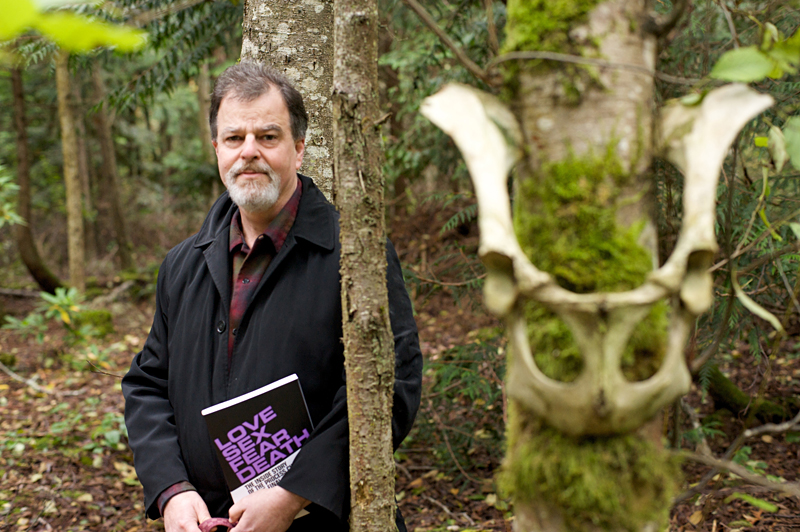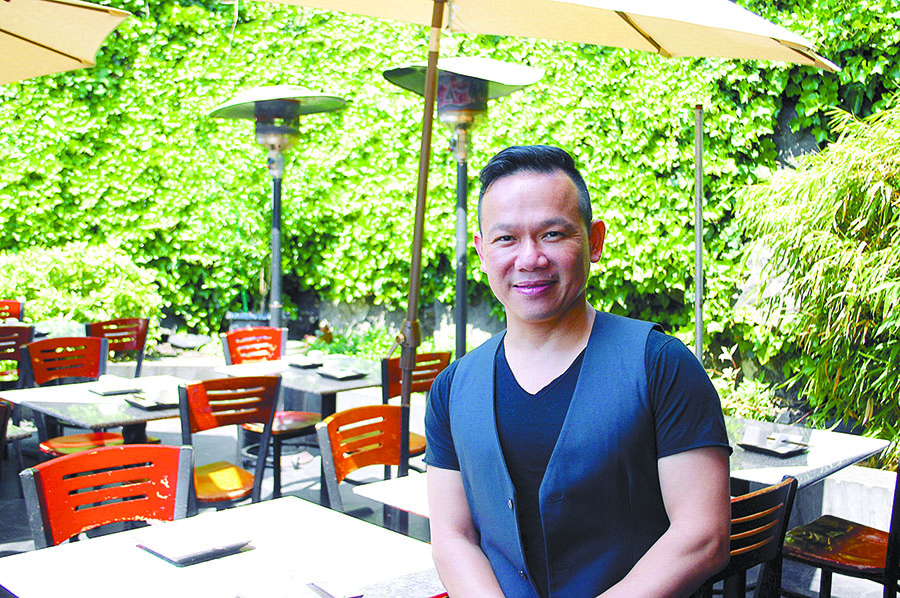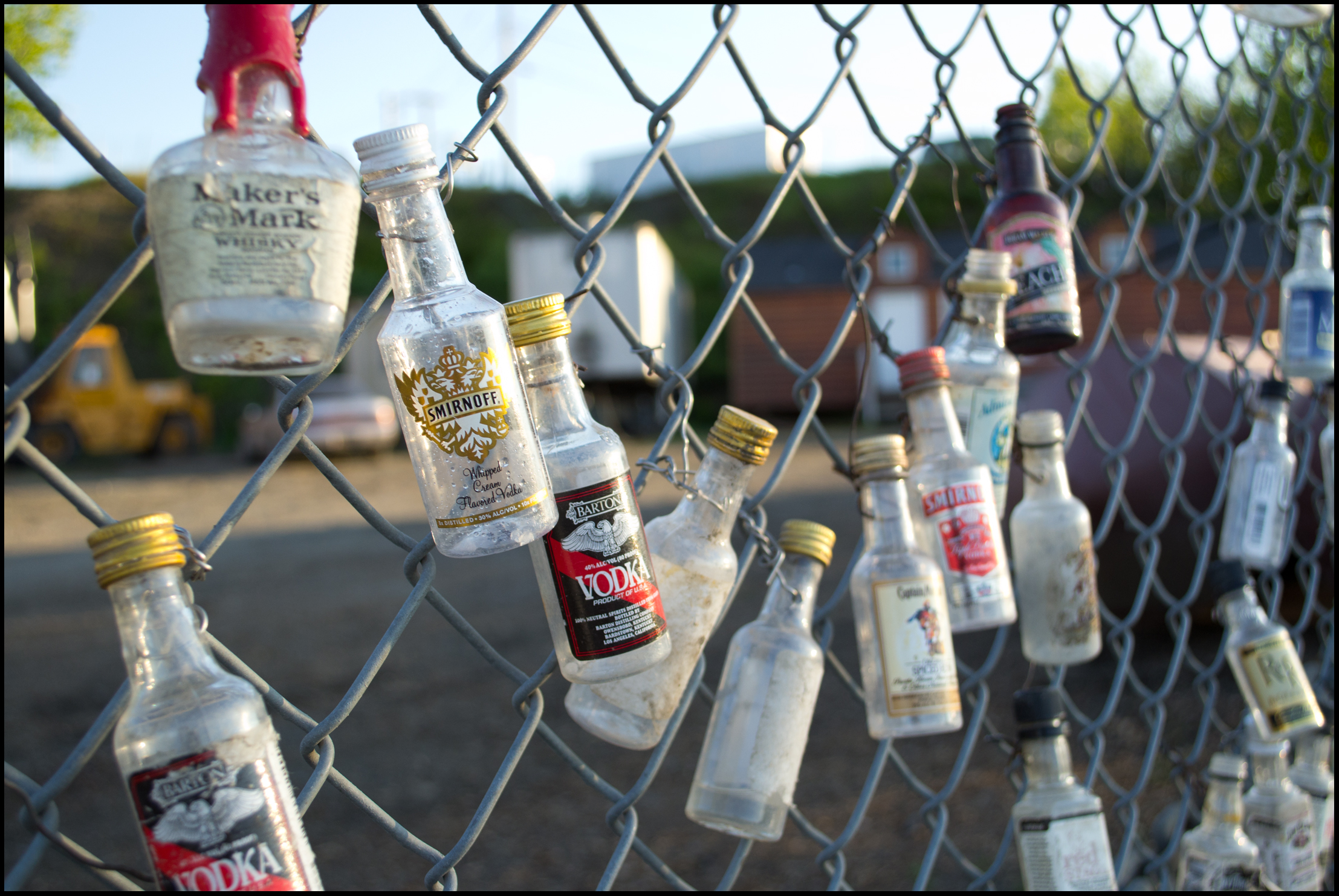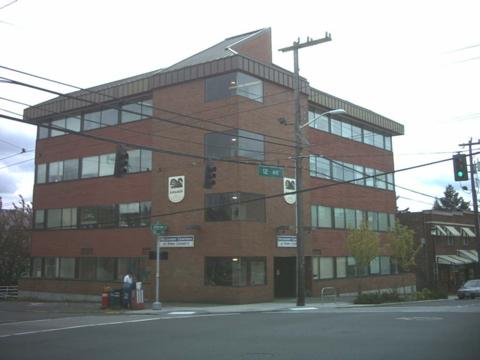On a brilliant, sun-dappled October afternoon, Adam Parfrey, one of the nation’s most provocative publishers, is in his front yard frolicking with his dog Loki—a beast of an animal, half malamute, half King Kong, named for a Norse god connected with fire and magic.
As the doggie play continues, a young hiker approaches Parfrey’s home, a cavernous grey-painted dwelling with dark-purple shutters and bookshelves that climb toward 14-foot ceilings. Outside, the leaves are a crunchy red and gold, and the moldering scent of fall has fully settled in. It was the bare-knuckled beauty of Port Townsend’s windswept outskirts and a romantic impulse to live off the land that persuaded Parfrey to relocate his unconventional, pot-stirring publishing house from Los Angeles three years ago.
The man, wearing tan knickers and toting a satchel he’s been using to gather mushrooms, stands near the gate, a stone’s throw from the chicken coop, greenhouse, and outdoor garden where Parfrey—when he’s not riling the cultural establishment with grisly tomes of unrepentant necrophiles, Satanists, the most explicit pornographers, and insidious murderers—tends to his brussels sprouts, berries, and tomatoes.
“I enjoy having my hands in the soil,” Parfrey says—a key reason he left his Silver Lake bungalow in the low-lying Hollywood Hills, not far from the home Howard Hughes built for his girlfriend in the 1930s. “I guess you could say it keeps me grounded—literally.”
At last, the blue-eyed, blond forager comes bounding onto Parfrey’s spread, four lush acres that unfurl along a bluff overlooking the Strait of Juan de Fuca. The scene is straight out of The Sound of Music. One expects any moment that the knickered lad will belt out a chorus of “Edelweiss.”
“I am a permaculturalist,” he announces. “I tend to the land so the land can grow itself.” Then, as if completing a magic trick, he plucks from his bag a matsuki mushroom the size of a catcher’s mitt and proudly hands it to Parfrey. The publisher, now an avid farmer as well, takes a knife to the ‘shroom and keeps half. He thanks his visitor and bids him farewell.
Encounters like this can happen at the drop of an incense stick in Port Townsend, where ex-hippies, New Agers, and, presumably, young Germanic-looking permaculturalists rule the roost. Situated on a natural harbor, the city, with a present-day population of 8,800, was once known as the “City of Dreams,” as hopes ran high that someday Port Townsend would boast the largest harbor on the West Coast. That never happened, but today grand Victorian mansions dot the uptown bluffs that rise above the city’s bustling spine, Water Street. The brick warehouses and three- and four-story brownstones that back up to the wharves of Admiralty Inlet have been turned into an eclectic stew of cafes, saloons, and clothing boutiques. There’s a delightful eccentricity to the place; as the bumper sticker taped to the storefront window of the PT Shirt Company reads: “We’re all here because we’re not all here.”
For years, Port Townsend was the home of Loompanics Unlimited, a publishing house founded by Mike Hoy. It was known for its rare and weird books, addressing assaultive topics such as drugs and anarchy and putting out how-to guides on, for example, manufacturing counterfeit IDs. It was Loompanics, in fact, that first put this Olympic Peninsula seaport on Parfrey’s radar screen. (Loompanics went out of business in 2006.)
“Every other neighbor we have probably was involved in a radical socialist experiment in the 1960s or 1970s,” observes Parfrey’s wife, Jodi Wille, an accomplished rock-band photographer and documentarian, whose abiding interest in cults and subcultures brought her into Parfrey’s curious orbit.
For his part, Parfrey blithely declares: “I’m not here for the scene.”
Indeed, Parfrey has more serious fish to fry, though he does find time to attend meetings of the local mycological society, mushroom enthusiast that he is. For more than six years, Parfrey carried on an intense written correspondence with the Unabomber, Theodore J. Kaczynski, which would culminate in Parfrey’s announcement this past June that he would publish a book by him.
Parfrey’s decison to reacquaint the Unabomber with the general public comes as no surprise to those who’ve collaborated with the maverick publisher over the years. His reputation is well known in the industry, running the gamut from dangerous sensationlist to fearless visionary.
There’s a reason, after all, that Parfrey calls his relatively small nonfiction publishing concern Feral House. Its apt motto: “Refuses to be domesticated.”
Parfrey is a soft-spoken, unassuming man, with a grey-speckled beard and brown tufts that sprout from a receding hairline. He stays fit with a little foraging himself and an occasional round of hot hatha yoga (“I sweat my pants off”). He’s polite, bright as hell, and as cautious as a diamond cutter when choosing his words. He was once sonorously described by Salon as “equal parts P.T. Barnum, Rod Serling, and Hegel.”
The son of Hollywood character actor Woodrow Parfrey (who played Dr. Maximus, one of the three “See No Evil” orangutan judges in Planet of the Apes), the 53-year-old Parfrey, the iconoclastic force behind Feral House, has long relished putting into print publications that no one else dares touch.
“I want people to question things—that not everything is in The New York Times, which, as they say, is ‘All the news that’s fit to print.’ I wanted to include the unfit,” Parfrey says with a mischievous grin.
Or, as he wrote in the preface to the second edition of Apocalypse Culture, the seminal 1987 anthology he conceived and edited before starting Feral House (and which would put him on the map as the enfant terrible of the publishing world): “The reader of Apocalypse Culture will soon begin to notice a preponderance of materials from individuals who have the audacity to consider themselves their own best authority, in repudiation or ignorance of the orthodoxy factories of Church, University, or State.”
Jim Nichols is vice president of sales at Consortium Book Sales & Distribution. Based in Minneapolis, the company represents nearly 100 independent publishers throughout the world, with Feral House a prized client. “Adam is a fearless champion of free speech and opinion,” declares Nichols. “He’s pretty unique in the industry. I can’t think of anyone who approaches his style of publishing. His books definitely get noticed.”
Among the many audacious individuals Parfrey has given voice to is Peter Sotos, a world-renowned pedophile who in the mid-1980s put out a short-lived magazine named Pure, a depraved compendium of serial-killer lore and the “sublime pleasures” of child abuse. Parfrey included an interview with Sotos in Apocalypse—which has sold 100,000 copies, by far his most successful title. At one point, Sotos is asked by interviewer Paul Lemon what he finds admirable about rampant killers.
“I don’t find everyone who kills, beats, or rapes [as] someone admirable,” he replies. “I’m interested and respectful of those who view and understand their instincts . . . My tastes run very similar to Ian Brady [who killed five children in England in the mid-1960s], and I enjoy his work because it is 100 percent honest and self-conceived. He fucked and tortured little Lesley Downey every way imaginable before smashing her tiny skull in half. I find fuckups like Charles Manson and Ed Gein terribly boring and laughable because they had no idea of what they really wanted.”
There’s also a chapter devoted to Karen Greenlee, who had a keen taste for dead men in their early 20s. She made headlines in the mid-’80s when, as an embalming assistant at a Sacramento mortuary, she drove off in a hearse and wasn’t heard from for two days. Instead of delivering the body to the cemetery, Greenlee spent some quality time with the deceased.
“Sure, I find the odor of death very erotic,” she’s quoted as saying. “There are death odors and there are death odors. You get your body that’s been floating in the bay for two weeks, or a burn victim, that doesn’t attract me much, but a freshly embalmed corpse is something else . . . When you’re on top of a body it tends to purge blood out of its mouth, while you’re making passionate love. You’d have to be there, I guess.”
Parfrey himself weighs in with a few curious incantations to this “exhaustive tour through the nether regions of today’s psychotic brainscape.” In one piece he issues a fanciful mediation on the case for self-castration, writing that nowadays “symbols of the castrated penis, the tie and bow tie, are the mandatory accoutrements of diplomatic wardrobe.” In another article, titled “Aesthetic Terrorism,” he states: “The onslaught of Muzak, ad jingles, billboards, top-40 tunes, commercials, corporate logos, etc., all fit the terrorist dynamic of intrusion and coercion.”
With a wry grin, Parfrey confides, “I can’t tell you how many people have come up to me and said that Apocalypse Culture changed their lives.”
Asked why and how, an awkward silence ensues before he finally volunteers, “Let me think about how I want to say this. I think it is that the culture that was provided them in school and so on was expanded [in Apocalypse] and torn apart.”
Exhibiting boundless fascination with the taboo, Parfrey has published more than 100 books since Feral’s beginning in 1989. The business, with two employees and a handful of distributors in New York, Canada, and Europe, occupies nearly half of his Port Townsend compound. Some of his titillating titles include The Devil’s Notebook, The Satanic Witch, Lords of Chaos, The Carnivals of Life and Death, and SuicideGirls—as well as The Compleat Motherfucker, a history of the mother of all dirty words, and Shit Magnet, a book chronicling “one man’s miraculous ability to absorb the world’s guilt.”
Another title that has enjoyed relative popularity was 1996’s Death Scenes: A Homicide Detective’s Scrapbook—grotesque black-and-white photos, primarily of dead, naked crime victims, from the collection of Jack Huddleston, an overwrought Los Angeles homicide cop in the 1940s and ’50s. In the introduction to Death Scenes, novelist Katherine Dunn (Geek Love) reveals that Huddleston “started out terrified and ended up liking it, fascinated, an aficionado.” With one horrific photo of a hanging victim, Huddleston includes the heartless caption “A little throat trouble.”
“What’s unique about Adam is that he treats all the so-called lunatics with respect,” notes Michael Moynihan, the Vermont-based author of Lords of Chaos, about the “bloody rise” of the early black-metal scene in Northern Europe. “Once you get past all the media demonizing, some of his stuff is very consequential—not just mad ravings.”
Sean Tejaratchi, a Los Angeles graphic designer who has created nearly 40 book covers for Parfrey, says the offbeat publisher is captivated by those whose worldview may seem inexplicable to most people. “Adam likes unique viewpoints which people feel very strongly about. It is the quality of that view that he’s attracted to, no matter how weird it may be.”
Seattleite Charlie Krafft, a ceramic artist, has happy memories of 1992, the year Parfrey, “my good buddy,” published Cad: A Handbook for Heels (“The Forgotten Lore of the Red-Blooded American Male”). “It was this oversized paperback magazine, a pre-feminist men’s magazine,” recounts Kraft. “It was politically incorrect and had a lot of soft-core porn in it.”
Cad brims with stories on burlesque, exotic music, and tiki culture, as well as essays on the history of rum and the secret to a perfect martini. “Cad was the most proscribed book I ever published,” Parfrey told Modern Drunkard Magazine in a 1996 interview. “It was banned in Canada . . . Some bookstore owners screamed at my distributor sales reps, ‘We nailed this door shut long ago! Get this book the fuck out of here!'”
Parfrey was also asked to share a particularly memorable drinking story with Modern Drunkard, which described him as “America’s most dangerous publisher.” He recalled an evening “guzzling up a storm” with Boyd Rice, a subcultural icon who first gained national recognition in 1975 when he, then 19, was whisked away by Secret Service agents as he tried to present First Lady Betty Ford with a skinned sheep’s head.
Recalled Parfrey in the interview: “I forgot the joke I told, but Boyd was laughing so loud and so hard that we all joined in and kept at it for like five or 10 minutes. Then I noticed the bar pianist clutching at his chest and spilling forward onto his face, suffering a massive heart attack. I was trying to call Boyd’s attention to this, but all my faces and finger-pointing made him laugh even louder and harder. I think that must have been the last thing this pianist heard as he was dying: our drunk voices laughing and screaming as loud as can be.”
In essence, what Parfrey does is publish books that explore the marginal aspects of culture. And in many cases—at least back when his interests were almost exclusively transgressive—he sheds light on subjects that society prefers to leave unexplored, carving a niche catering to those of us with an unseemly obsession with life’s darkest, most depraved sides.
Still, he bristles at being pigeonholed as an “underground” publisher. “That term diminishes the reality of what I do, which is to publish and write about things that perhaps little is known about in order to show another dimension,” explains Parfrey. “I do not try and shock people. That’s never been my intent, but rather to share aspects of culture that I find interesting.”
Later, his expression turns gently ironic, and he adds, “Werner Herzog once told me there is no such thing as counterculture. It’s all part of the culture.”
Between 1978 and 1995, Ted Kaczynski, a Harvard-educated mathematician, sent 16 package bombs. All of them exploded. Three people were killed and 23 others injured. The first bomb went to a materials-engineering professor at Northwestern University. It was followed by explosives mailed to a computer-store owner, an advertising executive, a timber-industry lobbyist, and a behavioral geneticist. One of the handcrafted devices was planted in the cargo hold of an American Airlines Boeing 727, forcing the pilot to make an emergency landing.
In 1971, two years after quitting his job as an assistant professor at the University of California at Berkeley, Kaczynski moved to a remote cabin near Lincoln, Montana, and lived as a recluse. It was the embittered Kaczynski’s contention that humanity evolved under primitive, low-tech conditions, and that only a violent collapse of the modern era’s daunting techno-industrial system could restore man to his natural state.
Caving to his promise to “desist from terrorism” if given a wide platform for his views, The New York Times and The Washington Post agreed in 1995 to publish his so-called manifesto, in which he conceded that the bombings were extreme but necessary to end technology’s evils.
Now incarcerated at the maximum-security prison in Florence, Colorado, Kaczynski, 68, lives on “Celebrity Row” with such incorrigibles as World Trade Center bombing mastermind Ramzi Yousef and, before his 2001 execution, Oklahoma City bomber Timothy McVeigh. Kaczynski has corresponded with several people during his confinement, including Parfrey, whose provocative essays about imminent global catastrophe, and the kinds of agitative authors he’d published, had not gone unnoticed by the Unabomber.
Beginning in 2003, Parfrey and Kaczynski exchanged dozens of letters, leading Parfrey to publish the “collected writings” of Kaczynski under the title Technological Slavery.
“The letters from him were extremely focused,” Parfrey recalls. “None of them were particularly revealing, other than to show his obsessive-compulsive behavior. I knew that he had published his work The Road to Revolution in 2008, in Switzerland [by Xenia Press], and that he was very unhappy with how that turned out. So I knew he was looking for [another] publisher.
“I had read his manifesto when it came out, and I found that there was more than just madness to him,” adds Parfrey. “I know he’s a killer and sociopath, but I found myself in agreement with a lot of what he’s written, and that his message is worth explaining.”
Parfrey was initially contacted by David Skrbina, a University of Michigan philosophy professor who also had corresponded at length with Kaczynski. The Unabomber found a kindred spirit in the professor, a pioneer in the field of ecosophy—or “deep ecology”—which emphasizes the interdependence of human and nonhuman life. It was Skrbina who convinced Kaczynski to produce a revised book, based on his prison letters and newly written essays.
For a time, Kaczynski and Parfrey haggled over what to call the book, a paperback with a 3,000-copy first printing. “He suggested Technological Suicide, and I said I wanted a new title,” remembers Parfrey. “Then he finally said Technological Slavery, which is exactly what I wanted in the first place.”
When news first surfaced in late September that Parfrey had published the Unabomber’s work, the Los Angeles Times reported that he and Skrbina had fretted over the moral issue of giving a convicted murderer this kind of vehicle to promote his beliefs. Absolutely untrue, says Parfrey, specifying that he and Skrbina “didn’t agonize over this at all. I wanted to publish it and I did.” (Kaczynski is forbidden by the so-called “Son of Sam Law” from profiting from his crimes, and will not receive a cent in book royalties.)
Recalls Skrbina: “Yes, I had concerns, obviously, about the crimes and the murders, but I was looking purely at arguments about technology that he was raising, and I said we [have] got to separate that.”
“There’s been no real anger at all,” adds Parfrey, citing the lack of negative reaction Technological Slavery has elicited. “Maybe that’s because a lot of his concepts don’t seem so weird to a lot of people.”
In fact, a number of contemporary critics of technology and industrialization agree with Kaczynski’s message, if not his violence, including John Zerzan, a leader of the primitivist movement in the U.S., and Herbert Marcuse, a renowned German political theorist who died a year after Kaczynski embarked on his bombing spree.
Then there is Bill Joy, the founder of Sun Microsystems, who in April 2000 wrote in Wired magazine: “I am no apologist for Kaczynski. His bombs killed three people during a 17-year terror campaign and wounded many others. One of his bombs gravely injured my friend David Gelernter, one of the most brilliant and visionary computer scientists of our time. Like many of my colleagues, I felt that I could easily have been the Unabomber’s next target. Kaczynski’s actions were murderous and, in my view, criminally insane. He is clearly a Luddite, but simply saying this does not dismiss his argument.”
Kaczynski, notes Parfrey, was not at all happy with Technological Slavery‘s final cover design, an FBI reconstruction of the homemade package bombs. Parfrey says the cover was a collaborative effort with Bill Smith, an artist who has designed covers for LA Weekly, Seattle Weekly‘s sister paper in Los Angeles.
Asked what troubled Kaczynski, Parfrey smiles and confides, “He said it was in bad taste.”
Parfrey studied history and theater at the University of California at Santa Cruz and later at UCLA before dropping out and using what he had left in tuition funds to head to San Francisco and bankroll two issues of an avant-garde tabloid he called Idea Magazine. It was the early ’80s, and Parfrey was heavily into punk rock, with notions of perhaps one day becoming a screenwriter or director, when an improbable bout of Dumpster diving led to a career in cutting-edge publishing.
Wandering down Sixth Street in San Francisco one day in 1982, Parfrey noticed that three large Dumpsters filled with hardcover books were being emptied into a dump truck behind a Goodwill store. “They were tossing away all the books, and I went in and asked the manager of the store, and he said they were only keeping the books that were shiny and new,” recalls Parfrey.
He rented a cheap pickup and began to sort the books, and for the next couple of years he was a wholesaler of used books in the Bay Area. He made enough money to buy a plane ticket to New York. “I worked at Strand Bookstore, but we [he and his first wife] lived mostly hand-to-mouth,” recalls Parfrey. “We got a woodstove, and we’d go out looking for used furniture and then bring it back to burn for heat.”
Parfrey managed to land on his feet, co-founding Amok Press with Ken Swezey in the mid-’80s. It was right up Parfrey’s literary alley, this catalogue of extremely unusual and hard-to-find books. With $5,000 in profit from Amok, Parfrey started Feral House.
Parfrey gained recognition of a positive kind in 1992—the year Cad made its madcap debut—when he published Rudolph Grey’s Nightmare of Ecstasy: The Life and Art of Edward D. Wood, Jr. In 1994, it was made into a well-received Tim Burton movie, Ed Wood, starring Johnny Depp. Wood was known for making poorly produced genre films such as Glen or Glenda, Bride of the Monster, and Plan 9 from Outer Space.
Parfrey also has been forced to weather some difficult times. It comes with the territory. As he puts it, “I don’t go looking for controversy, it finds me.”
It certainly found him in 1998, when he published The Oklahoma City Bombing and the Politics of Terror by investigative reporter David Hoffman. It made a number of searing allegations, centering on Hoffman’s contention that the government, working with militia groups, had advance knowledge that the Alfred P. Murrah Building would be bombed the morning of April 19, 1995.
“We got sued,” Parfrey says matter-of-factly.
The lawsuit was filed by a former FBI official named Oliver “Buck” Revell, who didn’t take kindly to Hoffman’s allegations that he was a co-conspirator in the bombing. Forced to ingest a heaping portion of crow, Parfrey, as part of a settlement, was ordered to destroy all copies of the book, including those in his distributor’s warehouse, in order to avoid “further dissemination of inaccurate statements.”
In an open letter, Parfrey wrote: “It is now my understanding that Mr. Revell had nothing to do with any alleged CIA drug smuggling, so-called ‘death squads,’ or malfeasance involving the Oklahoma City bombing, before or after.”
“It was a bad mistake,” Parfrey says. “But I didn’t have legal insurance and there was no way I could afford the cost of defending myself.”
Parfrey moves across Feral House’s inner sanctum, a vast, airy room, with most of his fringy titles carefully encased in bookshelves. The controversial publisher wears the slightly bemused look of a man who knows the world is full of chaos and irregularity. “I don’t think it is obsessive or crazy to look at things forthrightly,” he says of those who may criticize him for publishing material that hints of conspiracy. “You can call it exploitive, or you can dismiss it. But what is it? Why are people interested? Why do they want to know?”
One morning last month, Parfrey settles at a wooden table at the Salal Cafe on Water Street, where breakfast is served all day. The cozy eatery is bright, its walls festooned with watercolors, but empty save for a couple of women.
Parfrey orders bacon and eggs and glances at a Page 1 profile in the Port Townsend & Jefferson County Leader of Paul Richmond, a candidate for city prosecutor who supports an “enlightened” approach to marijuana prosecution. Parfrey, at heart a libertarian—he jokingly calls them “pot-smoking Republicans”—intends to vote for him.
The Salal, just down the street from the Nifty Fiftys Soda Fountain and the Boiler Room (a nonprofit performance space and cafe that boasts of having the “Best $1 Cup in Town”), is one of a few Port Townsend haunts favored by Parfrey. He makes an occasional foray to hoist a few at Sirens, a dimly lit pub atop the old C.C. Bartlett Building that offers a king’s view of Admiralty Inlet, and frequently stops at William James Bookseller, where a first edition of Ken Kesey’s Sometimes a Great Notion goes for $300.
Parfrey buys rare and used books here, and sells some Feral titles to owner Jim Catley. “I don’t know him well, but he likes my store,” says Catley, who has run the musty shop for 23 years. “He lies low and keeps to himself.”
Parfrey is a regular, too, at Colinwood Farms, buying organic produce and sometimes paying a visit to Chelsea Clancy, a farmer and onetime neighbor. “Yeah, me and my boyfriend Sam used to live near him for a year,” recalls Clancy. “Sam had bought some of his books, like Apocalypse [Culture], and when we met him, I thought, ‘Oh my God, I can’t believe we’re neighbors.’ He’s such a wealth of information, and a lovely man, too.”
Digging into his food, Parfrey begins to unspool memories of his rather exceptional childhood. He and his brother Jonathan were raised by a couple of bohemians: a father who took to the Broadway stage and a “very smart and imposing” mother who taught speech at New York City’s left-tilting New School for Social Research. In the early 1960s, Woodrow Parfrey left the stage and New York behind and brought his young family to Hollywood. He appeared in film and TV, most notably The Man From U.N.C.L.E. As a member of Clint Eastwood’s informal repertory company, he played small parts in The Outlaw Josey Wales, Bronco Billy, and Dirty Harry.
“My father also worked with Ronald Reagan on Death Valley Days in the early ’60s,” adds Parfrey. “And he told me once how he went out to lunch with him one day, and that Reagan told him that the communists were planting bombs under his [Reagan’s] car.”
Parfrey grew up in Malibu, two blocks from the beach, in a home often filled with his dad’s buddies, most of them hard-drinking actors and directors. “There was so many of them around all the time that I thought every father was an actor,” Parfrey says with a chuckle. “I remember once Jason Robards boozing it up with my father. They’d be making runs to the liquor store. So I was waking up the next morning, getting ready for school, and there was Robards still drinking, and going”—Parfrey imitates the actor’s deep voice—”‘Get back in your room, kid, it’s too early to get up!'”
The elder Parfrey fought in the Battle of the Bulge during World War II. He was wounded and taken prisoner by the Germans. Most of his regiment died of starvation. He weighed just 60 pounds when he was liberated. Appropriately enough, decades later he played the role of a prisoner in the 1973 classic Papillon, starring Steve McQueen and Dustin Hoffman.
Cutting the fat from his bacon, Parfrey says, “He never wanted to talk about the war. He hated the Germans and the Nazis. That’s why we never had a Volkswagen or a German shepherd.”
In the late 19th century, no other port city in America, aside from San Francisco, had a more rough-and-tumble waterfront than Port Townsend. So salacious was it—feral, one might say—that the odor of whiskey is said to have permeated the soil along Water Street to a depth of 10 feet. (Sounds like a certain Malibu household in the ’60s.) The only things more plentiful than booze were prostitutes—”soiled doves” and “demimondes,” as they were euphemized.
That’s hard to envision now as a few tourists drift past the stately Palace Hotel and head for a hot cup of java at the weathered Lighthouse Cafe. An early November mist has enveloped the town, bringing a cold fog that clings to an elegant stone structure on the corner of Taylor Street and Water. It’s Port Townsend’s first stone building, the Eisenbeis, built in 1873, back when the soiled doves were the city’s truest artists. Some of them plied their naughty craft at the old Delmonico Hotel and Restaurant, the most memorable business to occupy the Eisenbeis.
Beneath it lies the Undertown, where locals idle in conversation over coffee and croissants. To get to it, one must descend a steep stairway with green iron handrails and navigate a darkened 100-foot-long concrete tunnel. Inside the cave-like cafe, the walls are brick and stone. One room leads to another, all neatly lined with paintings for sale.
Dressed in a dark pea coat, Parfrey appears toward the front of the serpentine place. After collecting the coffee he’s ordered, he offers some small talk about the election, saying nothing really surprised him, not even Harry Reid pulling it out in Nevada.
Asked if there’s anything he’d draw the line at publishing, Parfrey quietly begins, “When I was in L.A., there was this Jewish I guy I knew who went to Auschwitz under the pretense that he was doing Jewish studies, but really he was into the whole Holocaust-revisionist thing.” The son of a POW who hated all things German, Parfrey adds, “No, I’m not going to get into that world.”
If there’s one thing Parfrey would most like to stress on this cold afternoon, it’s that Feral House’s nonfiction offerings, whether wacky, inflammatory, or highly educational, are not something he publishes on a whim.
“These are not finished products when they come to me; they are collaborative efforts. In fact, I’ve often been the co-writer on them and probably should have listed myself that way,” says Parfrey. “What I do is try to give readers something that is interesting, something they might not have explored before. That’s what floats my boat.”








